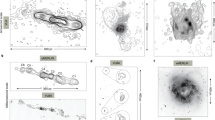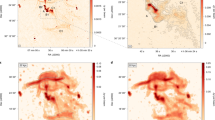Abstract
The nucleus of the Milky Way is known to harbour regions of intense star formation activity as well as a supermassive black hole1. Recent observations have revealed regions of γ-ray emission reaching far above and below the Galactic Centre (relative to the Galactic plane), the so-called ‘Fermi bubbles’2. It is uncertain whether these were generated by nuclear star formation or by quasar-like outbursts of the central black hole3,4,5,6 and no information on the structures’ magnetic field has been reported. Here we report observations of two giant, linearly polarized radio lobes, containing three ridge-like substructures, emanating from the Galactic Centre. The lobes each extend about 60 degrees in the Galactic bulge, closely corresponding to the Fermi bubbles, and are permeated by strong magnetic fields of up to 15 microgauss. We conclude that the radio lobes originate in a biconical, star-formation-driven (rather than black-hole-driven) outflow from the Galaxy’s central 200 parsecs that transports a huge amount of magnetic energy, about 1055 ergs, into the Galactic halo. The ridges wind around this outflow and, we suggest, constitute a ‘phonographic’ record of nuclear star formation activity over at least ten million years.
This is a preview of subscription content, access via your institution
Access options
Subscribe to this journal
Receive 51 print issues and online access
$199.00 per year
only $3.90 per issue
Buy this article
- Purchase on Springer Link
- Instant access to full article PDF
Prices may be subject to local taxes which are calculated during checkout




Similar content being viewed by others
References
Morris, M. & Serabyn, E. The Galactic Centre environment. Annu. Rev. Astron. Astrophys. 34, 645–701 (1996)
Su, M., Slatyer, T. R. & Finkbeiner, D. P. Giant gamma-ray bubbles from Fermi-LAT: active galactic nucleus activity or bipolar galactic wind? Astrophys. J. 724, 1044–1082 (2010)
Su, M. & Finkbeiner, D. P. Evidence for gamma-ray jets in the Milky Way. Astrophys. J. 753, 61 (2012)
Zubovas, K., King, A. R. & Nayakshin, S. The Milky Way’s Fermi bubbles: echoes of the last quasar outburst? Mon. Not. R. Astron. Soc. 415, L21–L25 (2011)
Crocker, R. M. & Aharonian, F. Fermi bubbles: giant, multibillion-year-old reservoirs of Galactic Center cosmic rays. Phys. Rev. Lett. 106, 101102 (2011)
Crocker, R. M. Non-thermal insights on mass and energy flows through the Galactic Centre and into the Fermi bubbles. Mon. Not. R. Astron. Soc. 423, 3512–3539 (2012)
Carretti, E. in The Dynamic ISM: A Celebration of the Canadian Galactic Plane Survey (eds Kothes, R., Landecker, T. L. & Willis, A. G.) 276–287 (ASP Conf. Ser. CS-438, Astronomical Society of the Pacific, 2011)
Hinshaw, G. et al. Five-year Wilkinson Microwave Anisotropy Probe observations: data processing, sky maps, and basic results. Astrophys. J. 180 (suppl.). 225–245 (2009)
Jones, D. I., Crocker, R. M., Reich, W., Ott, J. & Aharonian, F. A. Magnetic substructure in the northern Fermi bubble revealed by polarized microwave emission. Astrophys. J. 747, L12–L15 (2012)
Sofue, Y., Reich, W. & Reich, P. The Galactic center spur — A jet from the nucleus? Astrophys. J. 341, L47–L49 (1989)
Bland-Hawthorn, J. & Cohen, M. The large-scale bipolar wind in the Galactic Center. Astrophys. J. 582, 246–256 (2003)
Molinari, S. et al. A 100 pc elliptical and twisted ring of cold and dense molecular clouds revealed by Herschel around the Galactic Center. Astrophys. J. 735, L33–L39 (2011)
Aharonian, F. A. et al. Discovery of very-high-energy γ-rays from the Galactic Centre ridge. Nature 439, 695–698 (2006)
Crocker, R. M. et al. Wild at heart: the particle astrophysics of the Galactic Centre. Mon. Not. R. Astron. Soc. 413, 763–788 (2011)
Law, C. J. A multiwavelength view of a mass outflow from the Galactic Center. Astrophys. J. 708, 474–484 (2010)
Crocker, R. M. et al. γ-rays and the far-infrared-radio continuum correlation reveal a powerful Galactic Centre wind. Mon. Not. R. Astron. Soc. 411, L11–L15 (2011)
Crocker, R. M., Jones, D. I., Melia, F., Ott, J. & Protheroe, R. J. A lower limit of 50 microgauss for the magnetic field near the Galactic Centre. Nature 463, 65–67 (2010)
Yun, M. S., Reddy, N. A. & Condon, J. J. Radio properties of infrared-selected galaxies in the IRAS 2 Jy sample. Astrophys. J. 554, 803–822 (2001)
Launhardt, R., Zylka, R. & Mezger, P. G. The nuclear bulge of the Galaxy III. Large scale physical characteristics of stars and interstellar matter. Astron. Astrophys. 384, 112–139 (2002)
Heesen, V., Beck, R., Krause, M. & Dettmar, R.-J. Cosmic rays and the magnetic field in the nearby starburst galaxy NGC 253 III. Helical magnetic fields in the nuclear outflow. Astron. Astrophys. 535, A79 (2011)
Muno, M. P. et al. Diffuse X-ray emission in a deep Chandra image of the Galactic Center. Astrophys. J. 613, 326–342 (2004)
Pohl, M., Reich, W. & Schlickeiser, R. Synchrotron modelling of the 400 pc spur at the galactic center. Astron. Astrophys. 262, 441–454 (1992)
Hußmann, B., Stolte, A., Brandner, W. & Gennaro, M. The present-day mass function of the Quintuplet cluster. Astron. Astrophys. 540, A57 (2012)
Ferrière, K. Interstellar magnetic fields in the Galactic center region. Astron. Astrophys. 505, 1183–1198 (2009)
Brandenburg, A. & Subramanian, K. Astrophysical magnetic fields and nonlinear dynamo theory. Phys. Rep. 417, 1–209 (2005)
Beck, R. & Krause, M. Revised equipartition and minimum energy formula for magnetic field strength estimates from radio synchrotron observations. Astron. Nachr. 326, 414–427 (2005)
Gaustad, J. E., McCullough, P. R., Rosing, W. & Van Buren, D. A robotic wide-angle Hα survey of the southern sky. Publ. Astron. Soc. Pacif. 113, 1326–1348 (2001)
Kulsrud, R. & Pearce, W. P. The effect of wave-particle interactions on the propagation of cosmic rays. Astrophys. J. 156, 445–469 (1969)
Almy, R. C. et al. Distance limits on the bright X-ray emission toward the Galactic Center: evidence for a very hot interstellar medium in the galactic X-ray bulge. Astrophys. J. 545, 290–300 (2000)
Acknowledgements
This work has been carried out in the framework of the S-band Polarization All Sky Survey collaboration (S-PASS). We thank the Parkes Telescope staff for support, both while setting up the non-standard observing mode and during the observing runs. R.M.C. thanks F. Aharonian, R. Beck, G. Bicknell, D. Jones, C. Law, M. Morris, C. Pfrommer, W. Reich, A. Stolte, T. Porter and H. Völk for discussions, and the Max-Planck-Institut für Kernphysik for supporting his research. R.M.C. also acknowledges the support of a Future Fellowship from the Australian Research Council through grant FT110100108. B.M.G. and C.P. acknowledge the support of an Australian Laureate Fellowship from the Australian Research Council through grant FL100100114. M.H. acknowledges the support of research programme 639.042.915, which is partly financed by the Netherlands Organisation for Scientific Research (NWO). The Parkes Radio Telescope is part of the Australia Telescope National Facility, which is funded by the Commonwealth of Australia for operation as a National Facility managed by CSIRO. We acknowledge the use of WMAP data and the HEALPix software package.
Author information
Authors and Affiliations
Contributions
E.C. performed the S-PASS observations, was the leader of the project, developed and performed the data reduction package, and did the main analysis and interpretation. R.M.C. provided theoretical analysis and interpretation. L.S.-S., M.H. and S.P. performed the S-PASS observations. M.J.K. performed the telescope special set-up that allowed the survey execution. L.S.-S., M.H., B.M.G., G.B., M.J.K. and S.P. were co-proposers and contributed to the definition of the project. C.P. performed the estimate of the Hα depolarizing region distance. E.C. and R.M.C. wrote the paper together. All the authors discussed the results and commented on the manuscript.
Corresponding author
Ethics declarations
Competing interests
The authors declare no competing financial interests.
Supplementary information
Supplementary Information
This file contains Supplementary Text and Data 1-9, Supplementary Tables 1-3, additional references and Supplementary Figures 1-6. (PDF 1098 kb)
Rights and permissions
About this article
Cite this article
Carretti, E., Crocker, R., Staveley-Smith, L. et al. Giant magnetized outflows from the centre of the Milky Way. Nature 493, 66–69 (2013). https://doi.org/10.1038/nature11734
Received:
Accepted:
Published:
Issue Date:
DOI: https://doi.org/10.1038/nature11734
This article is cited by
-
Asymmetric eROSITA bubbles as the evidence of a circumgalactic medium wind
Nature Communications (2023)
-
Cosmic ray feedback in galaxies and galaxy clusters
The Astronomy and Astrophysics Review (2023)
-
Diverse metallicities of Fermi bubble clouds indicate dual origins in the disk and halo
Nature Astronomy (2022)
-
Fermi and eROSITA bubbles as relics of the past activity of the Galaxy’s central black hole
Nature Astronomy (2022)
-
Multi-scale feedback and feeding in the closest radio galaxy Centaurus A
Nature Astronomy (2021)
Comments
By submitting a comment you agree to abide by our Terms and Community Guidelines. If you find something abusive or that does not comply with our terms or guidelines please flag it as inappropriate.



